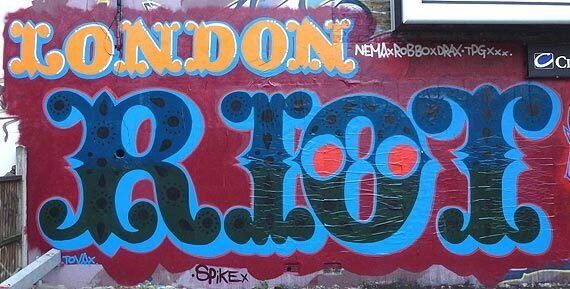
Ben Eine's November 2011 work London Riot was painted on a building in Hackney
I was sitting on a beach in Montenegro when my wife got a text saying the pub down the road from our home in London was being burnt to the ground.
The city, our neighbour told us, was on fire as rioters and looters ran amok.
It was a few days in to what would become known as the 2011 England riots, and as I wiggled my toes in the warm water of the Adriatic, it couldn't seem more alien to me the thought of what was going on.
I'd left the city a few days beforehand, reporting on the very start of the riots, as hundreds of people protested the police shooting of unarmed criminal suspect Mark Duggan.
As the first night of violence took hold, one of London's iconic double decker buses was set ablaze in Tottenham and the Carpetright building burned down, but by morning there was calm and a clean-up underway. As our taxi picked its way past cordoned-off streets on the way to Luton airport, there was no indication that the civil unrest was set to explode further across the country.
But explode it did, spreading like brush fire to several London suburbs as well as Birmingham and Bristol in The Midlands and Manchester and Liverpool in the North. Four days later, five people were dead, thousands had been (or were soon to be) arrested and £200million of damage had been caused by fires and looting.
Despite a fiscal downturn and a series of harsh cuts imposed by the government in the lead-up to the riots, it still seemed to come out of a clear blue sky. Few could have predicted the situation, but opinion afterwards about what caused it, its significance and the appropriate reaction, varied dramatically.
Appalled communities came together, the courts threw the book at rioters and looters, councils began evicting tenants and their families who were involved, and slowly the damage was covered over.
A report out on Tuesday blamed a lack of support for 500,000 "forgotten families" - a neglected 'underclass' it said. To some it was put simply down to bad parenting. Others blamed an already existing culture of spongers and petty criminals.
But significantly the report highlighted poor standards of education in some schools, some areas, that had led to one in five leaving school with the literacy levels of an 11-year-old. Compounding it, said the report, was a lack of jobs for school leavers.

As the riots exploded across London it prompted this response from Hackney-based graphic designer Nick Scott
Speaking to artists about their own response to the violence, the events of last August remain confused and uncertain.
A profession that normally sides with the underclass and with anti-authoritarian action, the arts community was fragmented in its reaction. Some, like Hackney-based designer Nick Scott expressed outrage at the violence. His poster Stop Smashing up London You Stupid Bastards! said it all.
Others attacked the rightwing response to the rioters and the harsh sentencing of the courts.
Many more approached the subject objectively, unable to make complete sense of why it had happened and unwilling to take sides.
Stan Karczmarz, a 52-year-old Polish émigré who came to London 25 years ago, painted through the night as he listened to radio reports of fires starting across the city.
His oil painting London Riots shows the Carpetright store and the bus burning in Tottenham with hooded silhouettes circling the fire like shamen. The reds and yellows and blues explode out of the centre of the collapsing building almost joyously, capturing the excitement of the rioters and the volatility of the occasion.
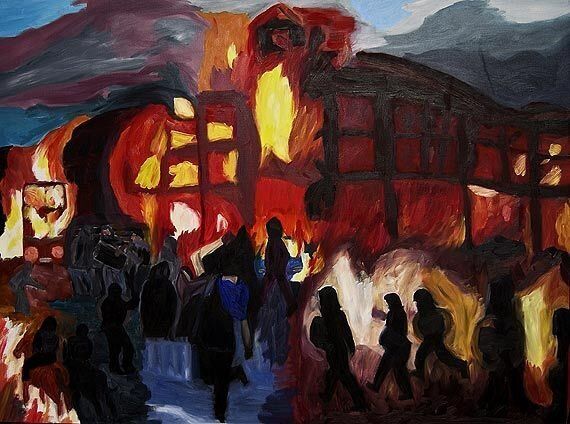
Stan Karczmarz worked through the night painting London Riot 2011
"In the afternoon it began and continued for weeks after the riots, fires and violent movements," said Karczmarz. I've lived in this town - in London - for 25 years and I love this city. I have followed every moment listening to the radio, reading newspapers, watching on the screen and on the street, but many unanswered questions arose.
"I started painting because I felt great firepower, the colours, noise, confused, angry young men. I felt like a double for the day following it all, and at night when I painted I wanted to present a whole action on one canvas."
Known as 'Pete the Street' Bath-based artist Peter Brown has made a successful career with his well-observed street scenes, land and sea scapes. His works have a tranquility that seems to suggest to the viewer the very action of an artist sitting before his easel gently and deliberately recording a scene that could hang on anyone's living room wall.
In the wake of the riots, however, Brown felt compelled to document the destruction and veer from his normal subject matter.
"On Monday, 8 August I was painting on Primrose Hill. There was an above average number of police sirens ringing around the city and a large group of mounted police trotted up Primrose Hill Road," he said. "The riots had kicked off on Saturday night and I think places like Ealing were experiencing it that afternoon.
"That night when I watched the news I wondered why I was painting on a hill during all this and thought it would be a good idea to try and paint the Carpetright on Tottenham High Street before it was levelled."
Brown got up the next morning, parked on Burlington Road and walked up Lansdowne Road to the police cordon. He set up his easel and began painting the TV camera crews, onlookers, police and cranes tearing down the ruined structure.
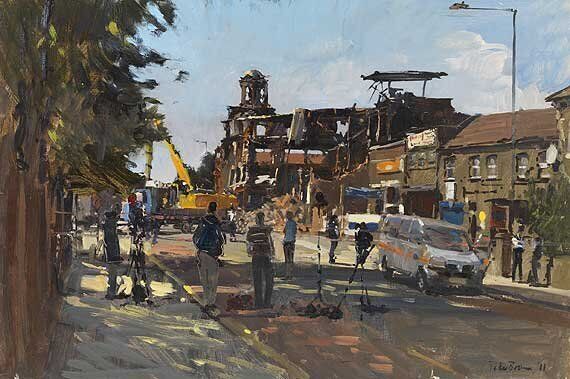
Peter Brown's Carpetright, Tottenham, was painted as the building was being torn down
"I set up there feeling very voyeuristic and worked on a 14 x 21," he said. "Various film crews from all around the world were coming and going, and I suppose I offered them another angle, if only for some footage. But on interview I was not a great story. I told them I didn't know enough to make any informed comment and that I wasn't much different to them in that I was just having a look.
"Those few days were, however, very moving. It was interesting that within the world of finance, when crisis hit, the reaction was to immediately protect your own position. The sense of dog-eat-dog got worse, and yet, here, there was a real feeling of community defiance."
Post Office workers asked Brown to come back and paint the building when it was restored and he watched a local jeweller "to and fro between his car and the black shell that was his life's work".
"Even on Thursday, five days after, there was a real feeling of shock," he said. "I felt bad when a woman walked past me and said 'It's not the Tottenham I know'. I wondered why I was preserving this scene. If someone had been killed, I don't think I could have.
"It took them three and-a-half days to make the high road safe, to re-tarmac, put up new traffic lights where the old ones had melted, and to remark the road. It was a concerted effort to paper over and move on. I drove away on Friday afternoon with a very positive view of that North London community."
Illustrator Ian Stevenson produced a poster Start Art Not Riots because he felt the initial protest over Duggan's death had given over to wholesale carnage with no political point.
He said: "I followed the riots on the internet and the TV. I was confused at what I was seeing and felt I had to create a piece to show my thoughts. I chose to represent the idea as a slogan as I wanted it to talk directly to the rioters in a language they understood. There are better ways to make a point than setting fire to buildings and putting peoples live in danger. I also created another piece which said 'Thou Shalt Not Riot For Cool Trainers'. They weren't 'fighting for' anything and instead just wanted some material goods to show off to their friends.
"It's never very arty to be against the rioter as we are all 'fighting against the system man', but I think there was an absence of support in the art community for the riots. Nobody really knows why it happened. Maybe people just wanted free stuff and had become completely selfish."
Graffiti artist Ben Eine, 41, who gained international fame when David Cameron presented one of his works to Barack Obama, has been living in the US for the past three years.
He "witnessed the chaos" from afar as the riots spread to his old home in East London and returned months later to spray paint London Riot on a wall in Hackney Road.
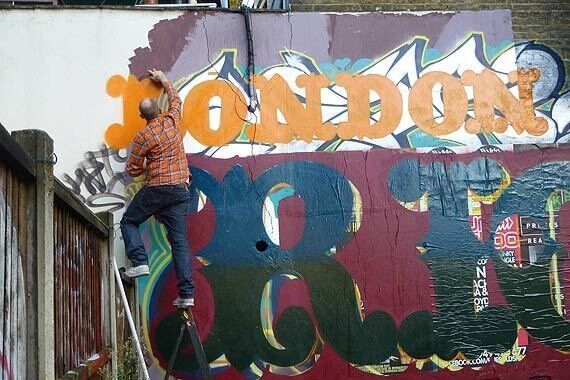
Graffiti artist Ben Eine at work on London Riot - he was in the US when the riots took place
He told me: "I personally believe the riots wouldn't have happened if it wasn't for the hot weather and the school summer holidays. The rain is London's greatest policeman. These two things, combined with the sense of social and financial inequality felt by our inner-city youth, resulted in the riots.
"Whilst this may not have been a conscious feeling among most, the riots swept up those who felt ignored by society and who felt that they had nothing to lose by behaving in such an unacceptable way.
"The riots themselves were nothing but destructive and anti-social but throughout history uprisings of this nature have bought great changes and may have at least brought the subject of dissatisfaction felt by the underclass back to the politicians debating table.
"The real story of the London riots is not of a window being smashed or a car being set on fire but the changes which will hopefully come about so that these people begin to feel like part of the group contributing towards society and not the sidelined minority. These talks and discussions are obviously taking place, yet only behind closed doors and not in a way where the general public feel their woes are being addressed.
"By writing the words 'London Riot' I was hoping to keep this debate in people's consciousness and as a reminder of how quickly things can spin out of control. We need to consider our own actions and behaviour towards each other to prevent people from feeling maligned and these incidences occurring."
Welsh sculptor and performance artist Dave Stephens produced a sculpture on the summer riots, using pictures from newspapers and a smashed plate.
He said: "It's not meant to be a comment on the riots rather a response to the imagery that came out of them. I was thinking about how energy when generated often seems to ignite. There seems to be a trigger mechanism that starts it all off."
Aged in his 50s and based in Brighton Stephens happened to be visiting a friend the night after rioters tore through Clapham in South London. He found large swathes of it boarded up.
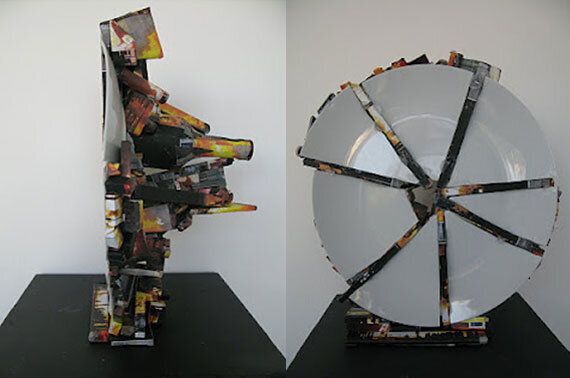
Dave Stephen's work was a reaction to the violent imagery of the riots
"It's hard to say what starts off a riot and probably there are many different causes," he said. "The flames seem to become a physical embodiment of the energy."
Watching the riots from his home in Port Jefferson, New York, US artist Anthony Freda also felt moved to document them, creating a work that shows a crow sitting above London Bridge and the city burning in the background. It is a piece that immediately conjures up images of the great fire of London, a rare historical reference in the art that the riots inspired.
Freda's view also, living away from the source of the trouble, was more objective, and shaded with that sense of historical perspective.
He said: "I watched in amazement as the first protests against police brutality in Tottenham spread and became something bigger and more profound. I heard two different takes on rioters. The authorities wanted to portray the rioters as gang members and lazy bums who had no justification for their outrage.
Their defenders were saying these were underprivileged victims rising up against social injustice. "I suspect that the truth is not as simple as either explanation.
"I wanted to comment on the importance of the events, without judgement of the participants. I still don't fully understand what happened, or what the implications for the future are, but I know the conditions that brought them upon us cannot just be swept under the rug."
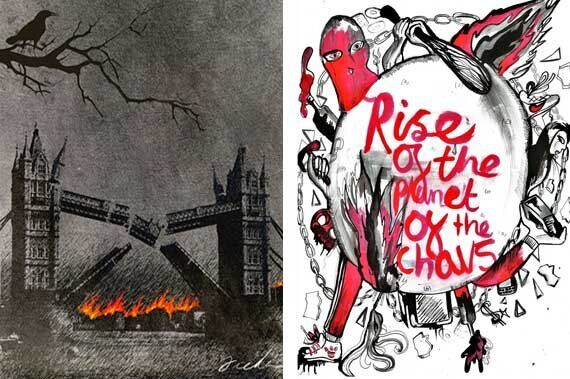
Anthony Freda referenced the Great Fire of London while Elizabeth Eisen was critical of the right-wing response to the rioters
Freda, who describes himself as a low-brow information warrior, added: "I wanted to create an image that made people think outside the narrow confines provided to them by most mainstream media."
Children's book illustrator Emmeline Pidgen produced a limited edition poster of 75 and raised over £1,000 for young people's charities Reclaim Project and Leap Confronting Conflict.
The 23-year-old, who published The Flyaway Blanket last year, is more used to sketching dragons and posies but said the community reaction of coming together after the riots inspired her to get involved.
"During the riots, what stood out in the midst of the destruction were the images of local communities of all ages and backgrounds working together to restore their neighbourhoods," she said. "It showed real strength of purpose and hope for a better future.
"I felt inspired by the positive attitude of the riot clean ups and tried to capture those feelings through illustration. I posted the artwork on Twitter to share it with my followers and friends, receiving an overwhelming response of over 19,000 views in two days."
Emmeline then got in contact with Riot Clean Up Manchester and organised an auction of prints in support of the community and charities. True to the post-riot spirit local businesses got involved to produce them free of charge.
Although the riots drew debate about social conditions, it was largely overshadowed by outrage and a desire to punish those involved. Civil strife frightens people, it gives them a glimpse of a society without rules, and the England riots were no different. CCTV captured at least one murder on film and the merciless assault and robbery of a student by a succession of people. Aside from my local pub being burnt down, crimes reported within a mile of where I live ranged from widescale looting to the rape of a 13-year-old girl by a teenage boy who had never been in trouble before and was said to be from a God-fearing Christian household.
Such was the snowballing effect of the mob violence, and often slow police response, people with no prior history of violence or disturbance became caught up in it. Some of the young people arrested were regarded as role models in their community before the riots.
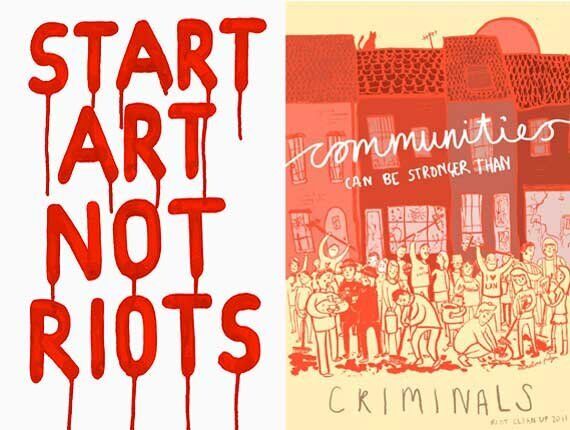
Ian Stevenson's Start Art Not Riots and Emmeline Pidgen's riot relief poster
Such images and the daily roll call of arrests and indignities that had been heaped upon the cities of England hardened attitudes quickly to those involved or suspected of it. And the fact that they had taken place in built-up areas in close proximity to large populations brought the violence home to a far greater number of people than is usual.
Art student Elizabeth Eisen produced her Planet of the Chavs painting as a sarcastic response to the hardline taken by many over the rioters.
She said: "I was obviously saddened and angered by the riots but I could completely understand that people were discontent with recent events, living conditions, government etc. and that something like this was inevitable if not condonable.
"Some of the comments I read from friends and acquaintances on Facebook and blogs that suggested using water cannons, drafting in the army, or were racist, classist or downright ignorant, shocked me.
"I was amazed by how right-wing so many people I knew became as a kneejerk reaction and without any consideration for the rioters backgrounds."
Though the courts are still processing cases and charred buildings are yet to be restored, for the most part discussion about the riots has subsided. Tuesday's report aside there has been little to no sign of the government addressing the conditions of a dissatisfied underclass that fed the unrest. Instead a raft of new welfare cuts and taxes await. What happens next is anyone's guess.
